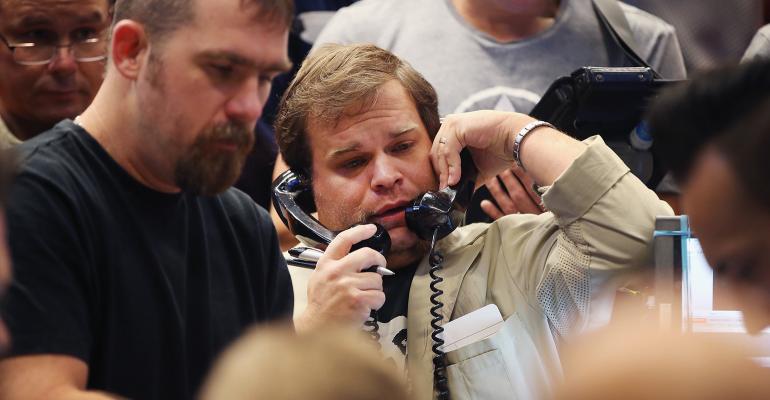Taking an active approach to managing fixed income investments, as opposed to relying on passively managed, index-based products, is gaining traction among both asset managers and financial advisors.
There’s a number of reasons for the sentiment: A larger number of less-than-desirable securities rolling off the Fed’s balance sheet and back into the market, along with the central bank’s upcoming rate hikes, mean many investment managers are reluctant to blindly “buy the universe” when it comes to this part of a client’s portfolio.
But perhaps even more, the desire to actively manage fixed income is, in fact, distinctly human.
That’s the message from financial planner and former banker Holly Donaldson, who has written a book on the psychology of money, where she discusses “behavior biases” among financial professionals and non-professionals alike.
“If I feel like I can't control something, I feel better about at least doing something than not doing something,” Donaldson explained. “So active products play to that bias—at least we’re doing something.”
Another bias that can draw advisors into active management could be called “advisor FOMO,” or fear of missing out. When advisors see peers actively managing their bond portfolios and delivering outperformance, they think they can win the active versus passive game as well, said Donaldson. “There’s enough people that have a good track record at [trading bonds] that it makes people think it's doable, even when they may or may not have the skill set or ability to do it,” she said.
A recent survey by active asset manager MFS Investment Management found that nearly 60 percent of advisors are confident that actively managed fixed income products will meet their expected returns, compared to just under 4 in 10 advisors feeling the same about passive products. When it comes to outperformance across market cycles, 64 percent of those surveyed pointed to active managers as their best option.
While the survey covers investment products, not an advisor’s practice, it could potentially be underrepresenting the number of financial advisors who think they can beat the market with an active approach. Angela Bender, managing partner at AMJ Financial Wealth Management in Leesburg, Va., described herself as “an active manager of mainly passive investments.” She looks at different macroeconomic indicators to inform her rotation decisions among passive fixed income ETFs.
Bender said it’s been a successful strategy so far. “It’s not really only the soundest approach to fixed income; it’s the soundest approach of asset management,” she said. While acknowledging that her approach can cost the client more than a simple bond aggregate, one has to evaluate what risks are in play as well. “What’s expensive to you?” Bender asked. “Is it more expensive to lose 3 percent of the holding? I think that the risk-return piece has to be part of that equation.” To be truly passive “you’d have to be in straight ETFs that never really moved around. And that ultimately means you’d have times of severe underperformance,” she said.
For purposes of the study, Bender would be categorized among the minority using passive products, but her practice is still an active one, said Donaldson. “They’re taking the passive [products] and they’re trying to put the puzzle pieces together in some kind of special strategy. They’re trying to get control again,” she added.
The evidence that investors can beat the benchmarks, even in fixed income, is contradictory. A 2011 Vanguard study warned that “investors should not assume that an active manager will automatically transform an opportunity to outperform into actual outperformance.” The investment management behemoth found that in a majority of rising-rate environments over past three decades, the “average actively managed bond fund” fell short of its benchmark, with “certain funds and strategies” occasionally outperforming. Contrast that with a 2017 PIMCO report that found that “active bond mutual funds have largely outperformed their median passive peers” in the past decade.
Some are sitting out the debate altogether. Fred Smoak, who started his career in fixed income and is now principal at Euclid Investment Advisory in Bethesda, Md., has little use for any bonds. After weathering the Great Recession, Euclid decided in 2010 that the firm would no longer invest in fixed income and turned to dividend stocks for income generation. “The fixed income market is very opaque. It’s difficult to know what you’re getting,” Smoak noted. In today’s market, he said, “there’s no upside to fixed income that I can see.”
With rising rates, it’s a stance that Smoak might reconsider if the sector becomes viable. But for now, with today’s macroeconomic picture, he’s in no hurry to render a verdict, active or passive. “That’s a difficult call,” he said. “For the moment I don’t have to make that decision. I’m not worried about it, yet.”
For most advisors, it’s helpful to be clear from the start with clients about the purpose of fixed income, said Donaldson; it’s usually intended as a ballast in a portfolio, not an alpha generator, and if that message can get across, the notion of active versus passive becomes less meaningful. “I can't tell you how many times a day I’m sitting with the money manager or the trust company and the manager is apologizing for the low returns in the bond,” she said, “instead of setting the expectations of their client: this part of your portfolio is not going to be very exciting, it's going to be very boring and that’s the whole purpose of it.”




